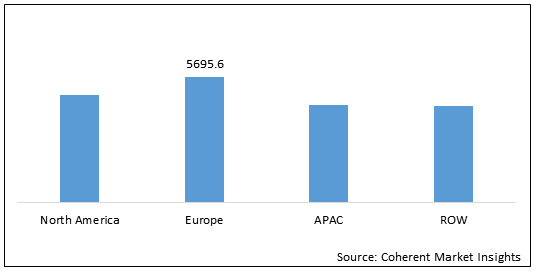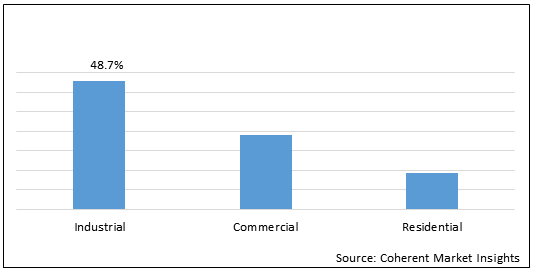Distribution automation (DA) is comprised of various technologies and protocols including sensors, processors, switches, and communications that monitor and control electric distribution systems without human involvement. It can increase the distribution system’s efficiency by saving systems and energy. Furthermore, it increases the reliability of the distribution system by reducing the frequency and duration of power outages. It also increases flexibility by allowing higher penetration of distributed energy sources. Apart from that, DA devices also provide operational and maintenance benefits such as improved reliability by reduction of outage duration by using an auto restoration scheme.
The global distribution automation market is estimated to be valued at US$ 20,821.6 million in 2021 and is expected to exhibit a CAGR of 8.5% over the forecast period (2021-2028).
Recent Developments:
In October 2021, Electricite de France S.A, partners with NTPC for further exploring the power project development opportunities in various regions such as Asia Pacific, Middle East, Africa, and Europe.
In July 2020, Siemens has launched new platform for designing customer specific applications for distribution grids.
In May 2020, Siemens has launched gas insulated, NXPLUS C 24 medium-voltage switchgear.
Statistics:
Figure 1. Global Distribution Automation Market Value (US$ Mn), by Region, 2020

To learn more about this report, Download Free Sample
Europe held dominant position in the distribution automation Market in 2020, accounting for 29.7% share in terms of Value, followed by North America and APAC, respectively.
Market Dynamics- Drivers
Enhancement of reliability and efficiency of distribution system is expected to drive growth of the global distribution automation market during the forecast period. Distribution automation is related to intelligent distribution systems that are fully controllable and flexible. It facilitates the efficient working of a smart grid. The reliability of an electric distribution system is important for both customers and utilities. Reliable electric supply uplifts economic development and growth, public safety and health, and also societal well-being. To improve efficiency and reliability, utilities demand real-time monitoring and remote control of systems and assets such as voltage regulators, capacitor banks, substations, feeder switches, and distribution transformers which ensure uninterrupted supply of power to consumers. For instance, as measured by SAIFI (System Average Interruption Frequency Index) and MAIFI (Momentary Average Interruption Frequency Index), diagnosis and notification of distribution automation equipment in advance helps in preventing equipment failures.
Reduced power outages time is expected to propel the global distribution automation market growth over the forecast period. Most power outages are caused by weather-related damage to overhead power lines. Vehicle accidents, animal contact, human error, and equipment failure also contribute to power outages. Moreover, ice and strong winds cause trees to fall on power lines or poles and sever or break them down. Distribution automation plays a critical role in outage prevention. The communication devices and sensors associated with distribution automation facilitate early detection of equipment that might not be working properly, thus preventing outright failure and allowing the utility company to replace them.
Market Opportunities
Rural untapped market can present lucrative growth opportunities. There is huge scope for distribution automation in rural areas. Increasing dependence on electrical equipment is making continuous power supply more significant, thus creating opportunities for utility companies to target the rural market by providing distribution automation services. Rural consumers have become more aware and can easily compare disparity in the number of supply interruptions between urban and rural distribution networks.
Technological developments can provide major business opportunities. Key companies in the market refocused on research and development activities, in order to enhance the product portfolio and gain a competitive edge in the market. For instance, in September 2013 Cooper Power Systems launched a new SPEAR recloser solution. This product provides the power industry with a cost-effective, dependable Smart Grid device to automate single phase circuits’ up to 38kV and also meet critical power requirements. Furthermore, in September 2013, Cooper Power Systems introduced the Grid Advisor Series 2 smart sensors that help to improve outage management and capacitor bank monitoring while providing real time-critical information not previously available in the marketplace.
Distribution Automation Market Report Coverage
| Report Coverage | Details | ||
|---|---|---|---|
| Base Year: | 2020 | Market Size in 2021: | US$ 20,821.6 Mn |
| Historical Data for: | 2017 to 2020 | Forecast Period: | 2021 to 2028 |
| Forecast Period 2021 to 2028 CAGR: | 8.5% | 2028 Value Projection: | US$ 36,918.4 Mn |
| Geographies covered: |
|
||
| Segments covered: |
|
||
| Companies covered: |
American Electric Power (AEP), Schneider Electric SA, Cooper Power Systems, General Electric Corporation, Dominion Virginia Power, Siemens AG, Électricité de France (EDF), S&C Electric Company, and Pacific Gas and Electric Company |
||
| Growth Drivers: |
|
||
| Restraints & Challenges: |
|
||
Uncover macros and micros vetted on 75+ parameters: Get instant access to report
Market Trends
Key companies in the market are focused on mergers and acquisitions, in order to enhance the market presence. For instance, January 2012, American Electric Power (AEP) acquired its independent retail electric supplier BlueStar Energy Solutions. Furthermore, in July 2013, Dominion Virginal Power acquired three solar projects in Indiana which are expected to generate a combined output of 28.6 megawatts of electricity.
Major market players are involved in contracts and agreements, in order to gain a competitive edge in the market. For instance, in April 2013, EDF entered into a corporation agreement with China Datang Corporation in the field of thermal energy.
Figure 2. Global Distribution Automation Market Share, By End-user, 2020

To learn more about this report, Download Free Sample
Key Takeaways of the Graph:
Market Dynamics- Restraints
Lack of standardization in communication infrastructure and technology is expected to hamper the global distribution automation market growth over the forecast period. Communication infrastructure is one of the prime factors of distribution automation. The key challenge in this area is to select proper communication infrastructure in order to acquire various field data based on the frequency, volume, and criticality of data transfer. At present global utilities are looking for a cost-effective and efficient solution for their communication needs. Different solutions which address these needs are available in the form of a hybrid model comprising various communication medium. For example, point-to-point connection via lease/copper line from service providers, wireless connection via CDMA / GPRS / V-Sat radio, and others.
Modernization of the existing switchgear is expected to hinder the global distribution automation market growth over the forecast period. Modernization of a utility’s existing switchgear in order to make it adaptable to automation is a prerequisite for every distribution automation project. This requires a huge capital investment. Due to the competitive and regulated environment, existing utilities find it challenging to go for complete automation. Based on their business requirements, some utilities identify strategic locations for automation within their operational area to meet customers’ needs. Currently, automation projects get executed in several phases, beginning with automating critical locations, realizing the benefits, and then automating the rest of the sites in subsequent phases with limited capital budget approved by the regulator.
Competitive Section
Key companies operating in the global distribution automation market are American Electric Power (AEP), Schneider Electric SA, Cooper Power Systems, General Electric Corporation, Dominion Virginia Power, Siemens AG, Électricité de France (EDF), S&C Electric Company, and Pacific Gas and Electric Company.
Key Developments
Key companies in the market are focused on product launches, in order to enhance the market presence. For instance, in June 2018, GE Power launched advanced distribution management solution (ADMS) in collaboration with Tata Power Delhi Distribution.
Share
Share
Missing comfort of reading report in your local language? Find your preferred language :
Transform your Strategy with Exclusive Trending Reports :
Frequently Asked Questions
Select a License Type
Joining thousands of companies around the world committed to making the Excellent Business Solutions.
View All Our Clients